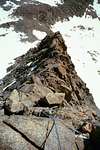|
|
Route |
|---|---|
|
|
37.09440°N / 118.5019°W |
|
|
Technical Rock Climb |
|
|
Most of a day |
|
|
5.6 |
|
|
Approach
Hike in either the North Fork of Big Pine Creek (preferred) or the South Fork of Big Pine Creek (cross-country most of the way), both from Glacier Lodge. If you approach from the North Fork, hike up to Sam Mack Meadows and then follow Glacier Trail up to the left side of the meadows. There are many nice campsites on the rocky ledges above Sam Mack, and some campsites in the moraine at the base of Mount Gayley.
Route Description
Hike across the Palisades Glacier to the base of Glacier Notch, the prominent notch between Mount Sill and Mount Gayley. The climb up to the notch is class 2 (at worst easy class 3) through a Gully on the right side of the notch. Once you gain Glacier Notch, hike up about a third of the way up the L-shaped couloir on Mount Sill. There are several places where you can cross over to the left to gain the Swiss Arete. All involve class 4 climbing, on moderate incline. Having reached the arete, climb up class 5 rock until you reach a headwall. There is a small platform with a triangular rock jotting out into thin air on the right hand side. This is NOT the famous step around move. Proceed straight up for half a pitch more until another headwall is encountered - you will need to step around on an exposed ledge to the right (off the arete) and climb an open book (5.6-5.7) - if you go left instead there is a hand crack that goes at 5.9. Once you have reached the top of the open book, the climbing gets easier - class 4 to 5.2. From the top of the open book, it is two long pitches to the summit.
You should plan on 5 long pitches if you start 1/3 of the way up the snowfield: 1 (class 4) to reach the arete, 1 to the false step around (5.5.-5.6), 1 to the top of the chimney above the step-around move (5.6), and 2 to the summit (class 4/5).
The return can be tricky. Follow the West ridge of Sill as if you were descending towards Polemonium Peak, over class 2 blocks. There are cairns to indicate where to angle right onto the West Face of Mount Sill, and also a large boulder which jots straight out of the ridge almost perpendicularly. At this point, downclimb or rappel a steep class 4 half-pitch (a 30 meter rappel is enough) and gain the ledges that criss-cross the West face of Sill. There are easily visible rappel stations which make this fairly obvious. A rappel can be preferable in the early season because the ledges are snow covered. Traverse the class 3 ledges towards the notch between Apex Peak and Mount Sill, and descend the L-Shaped couloir to Glacier Notch.
Essential Gear
We had a small rack with cams to 3". It is nice to have enough gear to be able to do longer pitches. We used very little passive pro. A 60 meter rope is helpful both for the rappel (30 meters - a 50 meter rope would be too short) and to climb longer pitches.
Miscellaneous Info
If you have information about this route that doesn't pertain to any of the other sections, please add it here.









MichaelJ - Aug 22, 2005 4:13 am - Hasn't voted
Route CommentI followed this route description (ie, climb a chimney) and when I came to the impasse I saw an open book around a corner and a crack to the left. Since I was looking for a chimney, I took the crack, which was more direct. It was fun but a bit burly. Reading other sources afterwards (Secor, et al) I learned that the open book IS the easy way around the impasse and that the crack goes at 5.9. There is NO chimney on this route. Since this is the crux of the climb, it seems rather important to get the beta right and note the variation.
Romain - Aug 23, 2005 2:17 am - Hasn't voted
Route CommentPorcella and Burns call it a chimney, and that's probably where I saw that description. My recollection of the spot is hazy because I did not lead that particular pitch. But I will change the description. Thanks for the input.